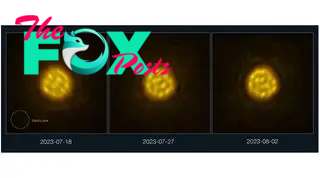Science
The bubbling surface of a distant star was captured on video for the 1st time ever
Astronomers have gotten the first-ever detailed views of turbulent activity in a star other than our own sun.
A time-lapse video released Sept. 11 shows enormous gas bubbles roiling on a nearby star called R Doradus, a red giant about 300 times bigger than our sun that lies roughly 180 light-years away, in the southern constellation Dorado. Like a boiling soup on a stovetop, the star's scorching material erupts on its surface in bubbles, which astronomers estimate swell to a whopping 75 times our sun's size.
"It is spectacular that we can now directly image the details on the surface of stars so far away," Behzad Bojnodi Arbab, a doctoral student at the Chalmers University of Technology in Sweden and a co-author of a new study about the observations, published Wednesday in the journal Nature, said in a statement. Thanks to the latest images, astronomers can now "observe physics that until now was mostly only observable in our sun," Arbab added.

The video is pieced together from the best-ever images of the star's chaotic surface, which were captured by a network of radio telescopes in Chile called the Atacama Large Millimeter/submillimeter Array, or ALMA for short. The images show the plasma bubbles, which are driven by heat rising from the star's core, crashing on its surface so violently that they appear to slightly deform the star.
Related: Betelgeuse, Betelgeuse? One of the brightest stars in the sky may actually be 2 stars, study hints
"We had never expected the data to be of such high quality that we could see so many details of the convection on the stellar surface," study lead author Wouter Vlemmings, a professor at Chalmers University of Technology, said in the statement.
From the latest snapshots of R Doradus, which ALMA captured from early July to August of last year, Vlemmings and his colleagues estimate the star's plasma bubbles rise and fall on a one-month cycle, which is faster than the timeline followed by similar convective cells abundant on our sun's surface.
-

 Science1d ago
Science1d agoInside Capitol Hill’s Latest UFO Hearings
-

 Science1d ago
Science1d agoYou Won’t Want to Miss the Leonid Meteor Shower. Here’s How and When You Can See It
-

 Science2d ago
Science2d agoHere’s What Trump’s Win Means for NASA
-

 Science5d ago
Science5d agoWhy Risky Wildfire Zones Have Been Increasing Around the World
-

 Science5d ago
Science5d agoIt’s Time to Redefine What a Megafire Is in the Climate Change Era
-

 Science1w ago
Science1w ago4 Astronauts Return to Earth After Being Delayed by Boeing’s Capsule Trouble and Hurricane Milton
-

 Science1w ago
Science1w agoThe Elegance and Awkwardness of NASA’s New Moon Suit, Designed by Axiom and Prada
-

 Science1w ago
Science1w agoSpaceX Launches Its Mega Starship Rocket. This Time, Mechanical Arms Catch It at Landing



























